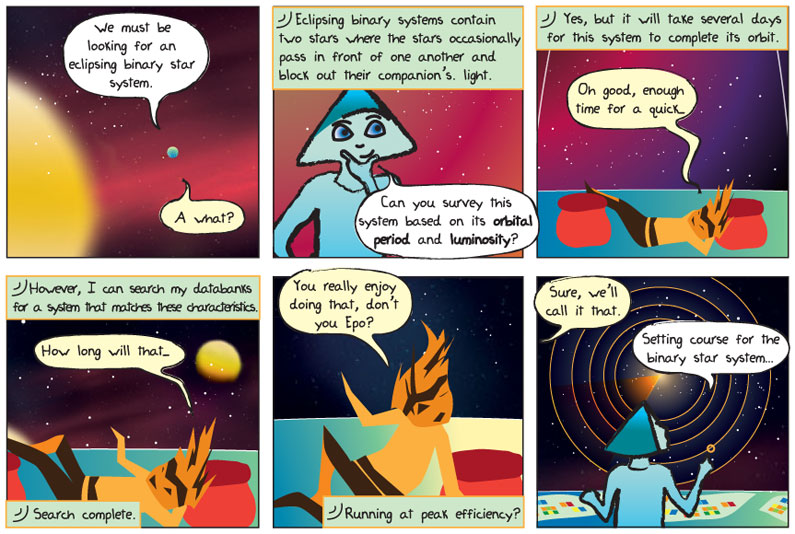
Transcript:
Panel 1
Alkina: We must be looking for an eclipsing binary star system.
Beggrin: A what?
Panel 2
Epo: Eclipsing binary systems contain two stars where the stars occasionally pass in front of one another and block out their companion’s light.
Alkina: Can you survey this system based on its orbital period and luminosity?
Panel 3
Epo: Yes, but it will take several days for this system to complete it’s orbit.
Beggrin: Oh, good, enough time for a quick…
Panel 4
Epo: However, I can search my databanks for a system that matches these characteristics.
Beggrin: How long will that…
Epo: Search complete.
Panel 5
Beggrin: You really enjoy doing that, don’t you, Epo?
Epo: Running at peak efficiency?
Panel 6
Beggrin: Sure, we’ll call it that.
Alkina: Setting course for the binary star system.
What does it mean?
Orbital Period – In a binary system, the time it takes for the two stars to complete one orbit around their mutual center of gravity.
Luminosity – A measure of the amount of light being generated by an object.
In human speak please!
Binary star systems are systems where two stars orbit each other, bound together by their mutual gravity. Astronomers have found that these systems are quite common. In some of binary systems we see periodic dimming of the light, which is caused by one star passing in front of the other. These events are called eclipses, and such systems are called eclipsing binary systems. While all binary systems orbit their mutual center of gravity, we do not see eclipses from all of them. In order to see an eclipse, there must be a special alignment between the stellar orbital plane and the Earth. It should be noted that most eclipses are not full eclipses where one star completely blocks out the other star in the binary system, since the two stars are not usually of the same size.
For example, if we view a binary system from above or below the orbital plane, then from our perspective both stars are always visible, and the amount of light we receive does not change. However, if we happen to be viewing the system from the side, such that the two stars and the Earth occasionally line up exactly with each other, then some of the light from the system will be blocked (one star passes in front of the other, as seen from the Earth). These passages are called eclipses. Of course, binary systems are usually comprised of two stars with different luminosities. When the brighter of the two stars eclipses the dimmer star, the drop in brightness is small. We call this the secondary minimum. When the dimmer star eclipses the brighter, the drop is larger, and we call this the primary minimum.
